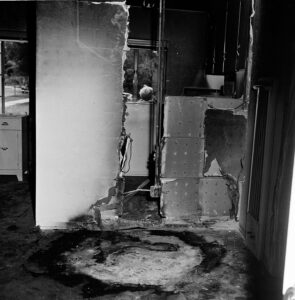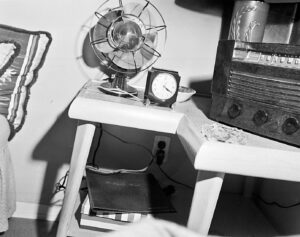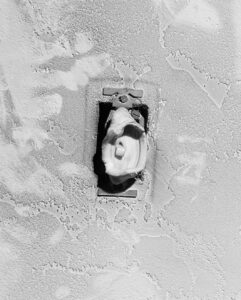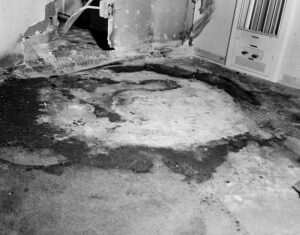
Mary Reeser. Family photo.
It’s unlikely that the circumstances of Mary Reeser’s death will ever be understood; the St. Petersburg Police Department’s most famous mystery languishes in the files, case closed but technically unsolved. There are no suspects, no fingerprints, no DNA, nothing of a forensic nature that might definitively say what reduced the 67-year-old widow to a smoldering pile of ashes on July 2, 1951.
Was it spontaneous human combustion, as believers in such things have postulated for decades? Probe-crazy aliens, Bigfoot and the Loch Ness Monster spawn theories, but none as morbid – or eerie – as those surrounding the death of Mary Reeser.
Despite the FBI’s declaration that Reeser had most likely fallen asleep in her reading chair, and her nightdress ignited by her dangling cigarette, skeptics point to the inconsistencies. Reeser’s tiny apartment remained virtually undamaged as the fire consumed her, her chair and the adjacent table and lamp. All that remained of the woman’s body was part of her left foot, still tucked inside its slipper.

St. Petersburg Times, July 3, 1951.
Details have changed over the decades, as the story has been told and re-told. And long the way, Mary Reeser became the poster child for spontaneous human combustion.
The facts are these. Richard Reeser, a physician in Columbia, Pennsylvania, died in 1947. His widow, Mary Hardy Reeser, sold their home in the fall of 1950 and moved to St. Petersburg to be close to her son, Dr. Richard Reeser Jr., his wife and their three young daughters.
A studio apartment was rented for her at 1200 Cherry Street NE, a few blocks southwest of the doctor’s home. Allamanda Apartments consisted of four connected bungalow-type units; Mrs. Reeser lived in the southeastern apartment. Her landlady, Pansy Carpenter, was in the northeast. The two in the middle were vacant.
Dr. Reeser stopped in every morning at 10 to have coffee with his mother. She often visited his big house on 19th Avenue, for Sunday dinner, or to babysit Marty, the youngest daughter.
But Mary Reeser was profoundly unhappy, her Pennsylvania friends later told investigators. She was terribly lonely in St. Petersburg, and missed her social circle back home. She resented being used as a convenient babysitter. She hated the heat and the humidity, and in an apartment without air conditioning, she was ready to say goodbye to Florida.
And despite what her son and his wife Ernestine told police, her friends said, Mary Reeser did not think much of her daughter-in law.
A planned summer trip north had just been called off, because her friends had been unable to find her an apartment.

Detective magazines of the 1950s had a field day with the salacious aspects of the Reeser case. From the collection of Brandy Stark.
Sunday, July 1
DR. REESER stated that the family had gone to the beach Sunday morning and returned home around 3:30 p.m. A short time after arriving home he found his mother sitting in a chair crying. He asked her what was wrong and she said that she was feeling bad about not being able to take her trip north … She asked the doctor to take her home, and he said that he would as soon as he had taken a shower. After taking a shower, he found that his mother had started to walk home, so he asked his wife to see if she could find his mother and give her a ride the rest of the way.
MRS. REESER stated that she had gone over to her mother-in-laws (sic) apartment Sunday evening and had stayed just a short time. She was unable to shed any light on the reason MRS. MARY REESER came home early Sunday.
DR. REESER went over to the apartment at 8 p.m. to see his mother and see if there was anything he could do for her. At the time he arrived she was sitting in her night gown. She told him she had taken 2 Seconals and would take 2 more before retiring. He left within a few minutes and did not see his mother again.
From the report by St. Petersburg robbery/homicide detectives Lee and Boyd
Secobarbital (also known as Seconal) is a powerful barbiturate used to treat insomnia, and to sedate patients prior to surgery. The drug was widely abused in the 1960s and ‘70s. Because of its addictive properties, it was discontinued in 2011.
Monday, July 2
At 8 a.m. a Western Union delivery boy handed a telegram, addressed to Mary Reeser, to landlady Carpenter. She brought the telegram, along with the morning paper, over to Reeser’s apartment. The older woman was usually up at dawn, and listening to her radio with the windows open. Not today.
Carpenter reached for the doorknob and found it hot to the touch. Fearing something was wrong, she called out to the departing delivery boy, and to two housepainters working across the street. The boy kept walking, but the painters, Albert Demet and L.P. Clements, responded.
Demet was the first person to enter Reeser’s apartment. The smell of smoke was prevalent, and the heat in the small space was intense. He briefly walked through, taking note that most of the furniture was undisturbed.
He then noticed the lower legs of a table, a piece of a lamp, and springs from what had been Reeser’s overstuffed chair – all that remained of it – with a few flames licking up from a mound of ashes beneath the charred metal. He saw Reeser’s foot, still in its black satin slipper.

Burned rug (foreground) shows the location of Reeser’s chair. Photo: St. Petersburg Police Dept.
Demet backed quickly out of the room and told landlady Carpenter to call the Fire Department.
Police discovered heavy smoke damage to the walls of the tiny apartment, starting approximately four feet from the floor. Everything below this line was untouched. Although light switch faceplates were melted and disfigured, the electric outlet faceplates below showed no damage.
The ceiling was completely blackened.
Several candles on a nearby buffet table had melted; curiously, their wicks stood erect.
The electric clock, sitting on a small table between two daybeds, had stopped at 4:20.

St. Petersburg Police Dept.
From the official police report:
Folding doors from living room to dressing area were scorched around the top. The heater in the living room appeared in good shape and was turned off. The bathroom was heavily smoked altho (sic) there was no damage to light fixtures. Two plastic bathing caps hanging behind door were not damaged. There was a heavy burning in the partition between the living area and the kitchen altho (sic) papers on the table top water heater which was against the wall were not scorched … none of the furniture left in the apartment shows any fire damage.
Mary Reeser, 5-foot-4, had died in her chair, and her 170-pound body had been consumed by a fire that did not spread to the rest of her apartment. Mixed in with the ashes were the steel coil springs from the overstuffed chair, a small bit of metal later determined to be a cigarette lighter, glass fragments, nightgown fibers, two charred table legs, pieces of the lamp and tiny bits of human bone, which included pieces of teeth, as well as a partial denture.

St. Petersburg Police Dept.
The rug underneath Reeser’s chair had been burned into a circle three feet in diameter; underneath the ashes was what investigators described as a “greasy substance.” It had also saturated the edges of the rug.
(Historically, it’s been repeated many times that Reeser’s skull was discovered, “shrunken to the size of a teacup,” along with a section of backbone. This information does not appear in any police reports, nor in the subsequent investigation report by the FBI. It is mentioned in the first reporting of Reeser’s death in the St. Petersburg Times, but has never been verified or confirmed.)

St. Petersburg Police Dept.
A lightning strike was ruled out, as was some sort of electrical failure (the wiring in the apartment was later checked out by electricians). There had been no gas leak in the kitchen. And, it was determined after talking with family members, Reeser was not suicidal.
Police Chief Jacob R. Reichert wrote to the Federal Bureau of Investigation, asking for help with the case. The ashes, and everything found with them, were forwarded to Washington, D.C., along with the death scene photographs.
Issued on July 31, the FBI report found no trace of accelerants, while conceding that such chemicals could conceivably had been used, and were destroyed in the fire.
The absence of any scorching or damage to the furniture in the room can only be explained by the fact that heat liberated by the burning body had a tendency to rise and formed a layer of hot air which never came in contact with the furnishings on a lower level. This situation would have occurred particularly if the fire had smouldered (sic) rather than burned freely.
 The FBI surmised that Reeser had been consumed by what scientists call “The Wick Effect”: The woman’s body fat (the “greasy substance” found on the rug and the floor) had turned her into a human candle.
The FBI surmised that Reeser had been consumed by what scientists call “The Wick Effect”: The woman’s body fat (the “greasy substance” found on the rug and the floor) had turned her into a human candle.
Once the body starts to burn there is enough fat and other inflammable substances to permit varying amounts of destruction to take place. Sometimes this destruction by burning will proceed to a degree which results in almost complete destruction of the body.
In this case it is entirely possible that the body was consumed to the extent shown in the photographs and as indicated by the bone fragments and other debris without the aid of any such material as gasoline. It is not generally realized to what extent the human body can burn once it becomes ignited.
While such cases are not common, there are on record numerous instances of bodies burning with almost complete destruction. It was formerly believed that such cases arose from spontaneous combustion or the burning was sometimes attributed to preternatural causes.
There is, however, no evidence from any of the cases on record to show that burning of his nature occurs other than when the body is ignited by some external means.

The telegram for Mary Reeser, it was later discovered, was from a friend back home, confirming that a place to stay had, in fact, been secured for her summer visit: She should start packing her bags.
Dr. Richard Reeser retired from private practice in 1980. He had served as chief of staff at Mound Park Hospital (currently Orlando Health Bayfront Hospital) from 1956 to 1960.
Interviewed in 1991, the 81-year-old physician said he’d accepted the FBI analysis as fact.
“I think the fire that consumed my mother’s body was so powerful because it fed on her own body fat,” Reeser told a Times reporter.
He recalled that final visit on July 1, 1951. “She was sitting in her easy chair with two fans blowing on her – she always kept two fans going,” he said.
“She hadn’t wanted any dinner, so the two Seconals she had taken would have been felt quickly. She was wearing a nightie. No bathrobe or housecoat, just a nightie. She was smoking a cigarette and seemed content. I kissed her good night.”

